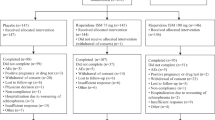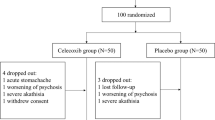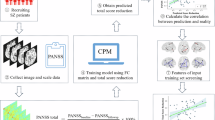Abstract
The bilateral communication between the immune and neuroendocrine systems plays an essential role in modulating the adequate response of the hypothalamic–pituitary–adrenal (HPA) axis to the stimulatory influence of cytokines and stress-related mediators. Growing evidence suggests that neuro-immune-endocrine crosstalk may be impaired in schizophrenia. We determined the relationship between cortisol, cytokines interleukin-2 (IL-2) and interleukin-6 (IL-6), and symptoms in schizophrenia during treatment with typical and atypical antipsychotic drugs. Subjects included 30 healthy controls (HC) and 78 schizophrenic (SCH) in-patients. SCH were randomly assigned to 12-week treatment with 6 mg/day of risperidone or 20 mg/day of haloperidol using a double-blind design. Clinical efficacy was determined using the Positive and Negative Syndrome Scale (PANSS). Serum cortisol and IL-2 levels were assayed by radioimmunometric assay, and serum IL-6 levels by quantitative enzyme-linked immunosorbent assay. Following a 2-week washout period, serum levels of cortisol, IL-2, and IL-6 were increased in patients with schizophrenia compared to HC. Elevations in cortisol were associated with increase in both IL-2 and IL-6 in SCH. Moreover, elevations in cortisol were associated with negative symptoms and IL-2 with positive symptoms. In all, 12 weeks of risperidone treatment significantly decreased elevated cortisol and improved negative symptoms, but produced similar effects on IL-2 and IL-6 as well as on positive symptoms compared to haloperidol. The improvement of negative symptoms was related to the change in cortisol. Our results suggest that the imbalance in the HPA axis and cytokine system in patients with SCH is implicated in clinical symptoms, and is improved with atypical antipsychotic treatment.
Similar content being viewed by others
Log in or create a free account to read this content
Gain free access to this article, as well as selected content from this journal and more on nature.com
or
References
Altamura C, Guercetti G, Percudani M (1989). Dexamethasone suppression test in positive and negative schizophrenia. Psychiatry Res 30: 69–75.
Altamura AC, Boin F, Maes M (1999). HPA axis and cytokines dysregulation in schizophrenia: potential implications for the antipsychotic treatment. Eur Neuropsychopharmacol 10: 1–4.
Arolt V, Rothermundt M, Wandinger KP, Kirchner H (2000). Decreased in vitro production of interferon-gamma and interleukin-2 in whole blood of patients with schizophrenia during treatment. Mol Psychiatry 5: 150–158.
Bethin KE, Vogt SK, Muglia LJ (2000). Interleukin-6 is an essential, corticotropin-releasing hormone-independent stimulator of the adrenal axis during immune system activation. Proc Natl Acad Sci USA 97: 9317–9322.
Blalock JE (1989). A molecular basis for bidirectional communication between the immune and neuroendocrine systems. Physiol Rev 69: 1–32.
Bumiller A, Gotz F, Rohde W, Dorner G (1999). Effects of repeated injections of interleukin 1beta or lipopolysaccharide on the HPA axis in the newborn rat. Cytokine 11: 225–230.
Chaouloff F (1993). Physiopharmacological interactions between stress hormones and central serotonergic systems. Brain Res Brain Res Rev 18: 1–32.
Chengappa KN, Ganguli R, Yang ZW, Shurin G, Brar JS, Rabin BS (1995). Impaired mitogen (PHA) responsiveness and increased autoantibodies in Caucasian schizophrenic patients with the HLA B8/DR3 phenotype. Biol Psychiatry 37: 546–549.
Coryell W, Tsuang D (1992). Hypothalamic-pituitary-adrenal axis hyperactivity and psychosis: recovery during an 8-year follow-up. Am J Psychiatry 149: 1033–1039.
Cox ED, Hoffmann SC, DiMercurio BS, Wesley RA, Harlan DM, Kirk AD et al (2001). Cytokine polymorphic analyses indicates ethnic differences in the allelic distribution of interleukin-2 and interleukin-6. Transplantation 72: 720–726.
Dinan TG (1996). Serotonin and the regulation of hypothalamic–pituitary–adrenal axis function. Life Sci 58: 1683–1694.
Ganguli R, Yang Z, Shurin G, Chengappa RKN, Brar JS, Gubbi AV et al (1994). Serum interleukin-6 concentration in schizophrenia: elevation associated with duration of illness. Psychiatry Res 51: 1–10.
Ganguli R, Brar JS, Chengappa KNR, Deleo M, Yang ZW, Shurin G et al (1995). Mitogen-stimulated interleukin-2 production in never-medicated, first-episode schizophrenic patients. Arch Gen Psychiatry 52: 668–672.
Geddes J, Freemantle N, Harrison P, Bebbington P (2000). Atypical antipsychotics in the treatment of schizophrenia: systematic overview and meta-regression analysis. BMJ 321: 1371–1376.
Haddad JJ, Saade NE, Safieh-Garabedian B (2002). Cytokines and neuro-immune-endocrine interactions: a role for the hypothalamic–pituitary–adrenal revolving axis. J Neuroimmunol 133: 1–19.
Hanisch UK, Rowe W, Sharma S, Meaney MJ, Quirion R (1994). Hypothalamic-pituitary-adrenal activity during chronic central administration of interleukin-2. Endocrinology 135: 2465–2472.
Henneberg AE, Horter S, Ruffert S (1994). Increased prevalence of antibrain antibodies in the sera from schizophrenic patients. Schizophr Res 14: 15–22.
Hoffmann SC, Stanley EM, Cox ED, DiMercurio BS, Koziol DE, Harlan DM et al (2002). Ethnicity greatly influences cytokine gene polymorphism distribution. Am J Transplant 2: 560–567.
Jansen LM, Gispen-de Wied CC, Gademan PJ, De Jonge RC, van der Linden JA, Kahn RS (1998). Blunted cortisol response to a psychosocial stressor in schizophrenia. Schizophr Res 33: 87–94.
Janssen PA, Niemegeers CJ, Awouters F, Schellekens KH, Megens AA, Meert TF (1988). Pharmacology of risperidone (R 64 766), a new antipsychotic with serotonin-S2 and dopamine-D2 antagonistic properties. J Pharmacol Exp Ther 244: 685–693.
Kaneko M, Yokoyama F, Hoshino Y, Takahagi K, Murata S, Watanabe M et al (1992). Hypothalamic–pituitary–adrenal axis function in chronic schizophrenia: association with clinical features. Neuropsychobiology 25: 1–7.
Kaneda Y, Fujii A, Ohmori T (2002). The hypothalamic–pituitary–adrenal axis in chronic schizophrenic patients long-term treated with neuroleptics. Prog Neuropsychopharmacol Biol Psychiatry 26: 935–938.
Kay SR, Fiszbein A, Opler LA (1987). The positive and negative syndrome scale (PANSS) for schizophrenia. Schizophr Bull 13: 261–276.
Kronfol Z, Remick DG (2000). Cytokines and the brain: implications for clinical psychiatry. Am J Psychiatry 157: 683–694.
Lammers CH, Garcia-Borreguero D, Schmider J, Gotthardt U, Dettling M, Holsboer F et al (1995). Combined dexamethasone/corticotropin-releasing hormone test in patients with schizophrenia and in normal controls. Biol Psychiatry 38: 803–807.
Licinio J, Seibyl JP, Altemus M, Charney DS, Krystal JH (1993). Elevated CSF levels of interleukin-2 in neuroleptic-free schizophrenic patients. Am J Psychiatry 150: 1408–1410.
Lin A, Kenis G, Bignotti S, Tura GJ, De Jong R, Bosmans E et al (1998). The inflammatory response system in treatment-resistant schizophrenia: increased serum interleukin-6. Schizophr Res 32: 9–15.
Maes M, Bosmans E, Calabrese J, Smith R, Meltzer H (1995). Interleukin-2 and interleukin-6 in schizophrenia and mania: effects of neuroleptics and mood stablizers. J Psychiatric Res 29: 141–152.
Maes M, Bosmans E, Kenis G, DeJong R, Smith RS, Meltzer HY (1997). In vivo immunomodulatory effects of clozapine in schizophrenia. Schizophre Res 26: 221–225.
Maes M, Bocchio Chiavetto L, Bignotti S, Battisa Tura G, Pioli R, Boin F et al (2000). Effects of atypical antipsychotics on the inflammatory response system in schizophrenic patients resistant to treatment with typical neuroleptics. Eur Neuropsychopharmacol 10: 119–124.
Maes M, Bocchio Chiavetto L, Bignotti S, Battisa Tura GJ, Pioli R, Boin F et al (2002). Increased serum interleukin-8 and interleukin-10 in schizophrenic patients resistant to treatment with neuroleptics and the stimulatory effects of clozapine on serum leukemia inhibitory factor receptor. Schizophr Res 54: 281–291.
Marx CE, Lieberman JA (1998). Psychoneuroendocrinology of schizophrenia. Psychiatr Clin North Am 21: 413–434.
Meltzer HY, Lee MA, Jayathilake K (2001). The blunted plasma cortisol response to apomorphine and its relationship to treatment response in patients with schizophrenia. Neuropsychopharmacology 24: 278–290.
Muck-Seler D, Pivac N, Jakovljevic M, Brzovic Z (1999). Platelet serotonin, plasma cortisol, and dexamethasone suppression test in schizophrenic patients. Biol Psychiatry 45: 1433–1439.
Muller N, Hofschuster E, Ackenheil M, Eckstein R (1993). T-cells and psychopathology in schizophrenia: relationship to the outcome of neuroleptic therapy. Acta Psychiatr Scand 87: 66–71.
Muller N, Ackenheil M (1998). Psychoneuroimmunology and the cytokine action in the CNS: implications for psychiatric disorders. Prog Neuropsychopharmacol Biol Psychiatry 22: 1–33.
Newcomer JW, Faustman WO, Whiteford HA, Moses Jr JA, Csernansky JG (1991). Symptomatology and cognitive impairment associate independently with post-dexamethasone cortisol concentrations in unmedicated schizophrenic patients. Biol Psychiatry 29: 855–864.
Rapaport MH, McAllister CG, Kim YS, Han JH, Pickar D, Nelson DL et al (1994). Increased serum soluble interleukin-2 receptors in Caucasian and Korean schizophrenic patients. Biol Psychiatry 35: 767–771.
Rapaport MH, McAllister CG, Pickar D, Tamarkin L, Kirch DG, Paul SM (1997). CSF IL-1 and IL-2 in medicated schizophrenic patients and normal volunteers. Schizophr Res 25: 123–129.
Sharma RP, Pandey GN, Janicak PG, Peterson J, Comaty JE, Davis JM (1988). The effect of diagnosis and age on the DST: a metaanalytic approach. Biol Psychiatry 24: 555–568.
Shirayama Y, Hashimoto K, Suzuki Y, Higuchi T (2002). Correlation of plasma neurosteroid levels to the severity of negative symptoms in male patients with schizophrenia. Schizophr Res 58: 69–74.
Song C, Lin AH, Kenis G, Bosmans E, Maes M (2000). Immunosuppressive effects of clozapine and haloperidol: enhanced production of the interleukin-1 receptor antagonist. Schizophr Res 42: 157–164.
Spangelo BL, Judd AM, Call GB, Zumwalt J, Gorospe WC (1995). Role of the cytokines in the hypothalamic–pituitary–adrenal and gonadal axes. Neuroimmunomodulation 2: 299–312.
Steensberg A, Fischer CP, Keller C, Moller K, Pedersen BK (2003). IL-6 enhances plasma IL-1ra, IL-10, and cortisol in humans. Am J Physiol Endocrinol Metab 285: 433–437.
Tandon R, Mazzara C, DeQuardo J, Craig KA, Meador-Woodruff JH, Goldman R et al (1991). Dexamethasone suppression test in schizophrenia: relationship to symptomatology, ventricular enlargement, and outcome. Biol Psychiatry 29: 953–964.
Walder DJ, Walker EF, Lewine RJ (2000). Cognitive functioning, cortisol release, and symptom severity in patients with schizophrenia. Biol Psychiatry 48: 1121–1132.
Walker EF, Diforio D (1997). Schizophrenia: a neural diathesis-stress model. Psychol Rev 104: 667–685.
Wang J, Dunn AJ (1999). The role of interleukin-6 in the activation of the hypothalamo-pituitary-adrenocortical axis and brain indoleamines by endotoxin and interleukin-1 beta. Brain Res 815: 337–348.
Wirshing DA, Marshall Jr BD, Green MF, Mintz J, Marder SR, Wirshing WC (1999). Risperidone in treatment-refractory schizophrenia. Am J Psychiatry 156: 1374–1379.
Yeragani VK (1990). The incidence of abnormal dexamethasone suppression in schizophrenia: a review and a meta-analytic comparison with the incidence in normal controls. Can J Psychiatry 35: 128–132.
Zhang XY, Zhou DF, Cao LY, Zhang PY, WU GY, Shen YC (2001). Risperidone versus haloperidol in the treatment of acute exacerbations of chronic inpatients with schizophrenia: a randomized double-blind study. Int Clin Psychopharmacol 16: 325–330.
Zhang XY, Zhou DF, Zhang PY, Wu GY, Shen YC (2002a). Elevated interleukin-2, interleukin-6 and interleukin-8 serum levels in neuroleptic-free schizophrenia: association with psychopathology. Schizophr Res 57: 247–258.
Zhang XY, Zhou DF, Cao LY, Zhang PY, Wu GY (2002b). Decreased production of interleukin-2 (IL-2), IL-2 secreting cells and CD4+ cells in medication-free patients with schizophrenia. J Psychiatric Res 36: 331–336.
Acknowledgements
We are grateful to Zhen Quan Guan and Li Sun for their technical assistance. Appreciation is also owed to the patients, clinical psychiatrists, and nursing staff of the Wards 1, 2, 4, 7, and 17, Beijing Hui-Long-Guan Hospital for their participation and collaboration. In addition, We thank Dr Colin Haile for his helpful revision on the manuscript. This study was supported by the Beijing Scientific and Technological New Stars Fund, Beijing, China (Dr XY Zhang).
Author information
Authors and Affiliations
Corresponding author
Rights and permissions
About this article
Cite this article
Zhang, X., Zhou, D., Cao, L. et al. Cortisol and Cytokines in Chronic and Treatment-Resistant Patients with Schizophrenia: Association with Psychopathology and Response to Antipsychotics. Neuropsychopharmacol 30, 1532–1538 (2005). https://doi.org/10.1038/sj.npp.1300756
Received:
Revised:
Accepted:
Published:
Issue date:
DOI: https://doi.org/10.1038/sj.npp.1300756
Keywords
This article is cited by
-
Sex differences in the association of treatment-resistant schizophrenia and serum interleukin-6 levels
BMC Psychiatry (2023)
-
Abnormal cortisol profile during psychosocial stress among patients with schizophrenia in a Chinese population
Scientific Reports (2022)
-
In schizophrenia, non-remitters and partial remitters to treatment with antipsychotics are qualitatively distinct classes with respect to neurocognitive deficits and neuro-immune biomarkers: results of soft independent modeling of class analogy
Metabolic Brain Disease (2021)
-
Glucose disturbances, cognitive deficits and white matter abnormalities in first-episode drug-naive schizophrenia
Molecular Psychiatry (2020)
-
Effects of short-term cannabidiol treatment on response to social stress in subjects at clinical high risk of developing psychosis
Psychopharmacology (2020)



